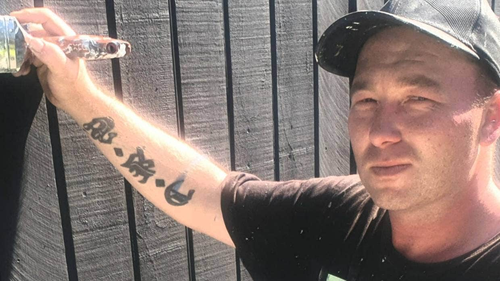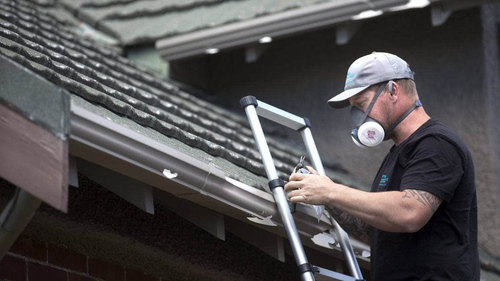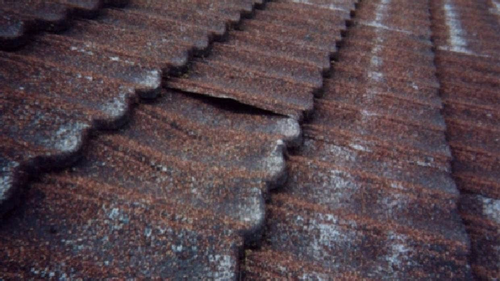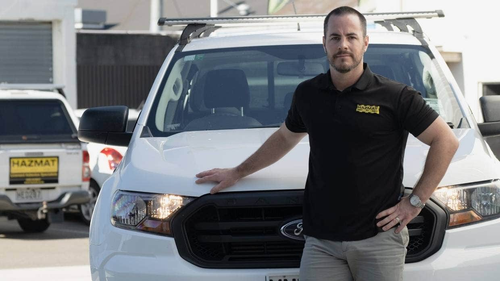“Scaffolding was erected, and while I was waterblasting the window frames, this lady came out and said, ‘Do you mind waterblasting the roof since you’re up there?’ I thought that’s not going to take long, but that turned out to be a big mistake.”

Mr Quaid says a neighbour called the council, and a representative came out and took a sample of the water run-off going down the drain and found it tested positive for asbestos.
“I had seen the neighbour coming out and looking at me doing the work and thought she was probably just looking at the dirt coming off. Neither myself nor the owner had any idea that the decramastic tiles contained asbestos. They had no paperwork with the title of her house to suggest there was asbestos in the roofing.”
Mr Quaid says the owner was required to move out of the house for several months while remedial work was carried out – water and run-off had found its way inside through window cracks. “I believe she only returned about three weeks ago and this happened five or six months ago. They had to replace the carpet and repaint the interior, amongst other things.”

The cost to Mr Quaid has been substantial.
His insurance company said asbestos issues are not covered by public liability insurance.
“I went to a lawyer, and she said at the end of the day, even though it wasn’t part of my original job, I should have done due diligence – homework in other words. The advice received by the homeowner was the same.”
The homeowner’s insurance covered most of the restoration, but Mr Quaid says they have asked him for $5000 to cover the excess and other costs – money he does not have. He says he is applying for a personal loan and hopes to be able to pay it off.
Mr Quaid, who is a Type 1 diabetic, says it has been “quite an ordeal”.
“It really got to me. I didn’t know how to deal with it. I went away for a week and when I came back the doctor diagnosed anxiety and depression.
“I had a mental breakdown and had to take a lot of time off work. The doctor gave me medication, and I have also been having counselling to get my head around things. I have slowly got back to work, but I am still catching up. I want to pay them and sort it out.”

‘I have waterblasted tiles like this before’
Mr Quaid says he has been a qualified painter for 18 years and hadn’t heard about asbestos in roofing tiles.
“I know about asbestos in other areas of a house, and I know what to look for. But I have been on jobs before, with the same roofing tiles, and waterblasted those without being aware, and I have seen other people doing the same thing.”
Mr Quaid says he hopes the episode will serve as a warning to other people waterblasting older decramastic tiles to do their homework first.
“Now, when I do roofs, I know [what can happen] and I can get an asbestos test done.”
Pre-80s decramastic tiles more likely to contain asbestos
The experience is no surprise to Chris Saunders, manager of asbestos removal specialist Hazmat in Wellington.
“I am astounded that to this day, many homeowners and contractors still don’t know, or claim not to know of the dangers of asbestos, or its presence in numerous building materials of older homes.

“A significant part of our business is in cleaning up asbestos contamination from DIY projects gone wrong. Unnecessary asbestos fibre respiration is very dangerous, and more media attention to the subject is certainly warranted in my view.”
“Mastic or bitumen was the most common material used to adhere the stone chip to the pressed metal at that time,” the company says on its website.
“All mastic or bitumen-based pressed metal roof tiles should be suspected of containing asbestos until proven otherwise. Particular profiles which are likely to be affected include decramastic and early Harveytiles. However, other profiles may be affected.
“Pressed metal roof tiles manufactured by other parties are believed to have been introduced and manufactured after the ban on asbestos was implemented, but the same care should be taken regardless for any pressed metal roof tiles which may contain a mastic or bitumen-based product.”
Hazmat also says there are no risks associated with pressed metal roof tiles containing asbestos if they remain in good condition and are left undisturbed.
“A significant health risk arises when adhesive expires, stone chips become dislodged and asbestos fibres may become airborne and can be breathed into the lungs. This may occur if the tiles may be disturbed during maintenance, cleaning or removal.”
Jeremy Gray of Builderscrack.co.nz says unforeseen asbestos issues aren’t common. “But because of the variety of materials that features asbestos throughout New Zealand’s building history, and the variety of jobs that homeowners have tradies do, Builderscrack strongly suggests if anyone is unsure or if they know asbestos has been used, they need to get advice from an expert.”
“For a relatively lower project cost, it may be possible to encapsulate asbestos safely, rather than remove it.”
This content first appear on 9news
